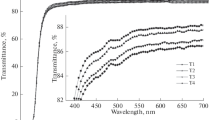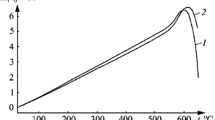Abstract
High refractive index glasses based on SiO2-(BaO + ZrO2)-TiO2 were synthesized for road sign applications with nd > 1.9. Although the refractive index increased with the addition of TiO2, visible transmittance was deteriorated with colorization of the glasses with increasing TiO2. Visible light absorption by the multi-valenced Ti-ions within the glass matrix was responsible for the change in color and transmittance. To improve transmittance and guarantee the retro-reflectivity of the glass beads, various transition metal oxides (TMOs) CuO, NiO, MnO and CoO were introduced for color control. The transmittance change with various TMOs was monitored, and a glass with CoO showed a noticeable change in color as well as an increase in transmittance. The valence change of Ti-ions was inspected by XPS, photo-luminescence (PL) and photo-luminescence excitation (PLE) spectra of the glasses, to elucidate the color change.









Similar content being viewed by others
References
L.A. Ivanov, D.V. Kiesewetter, N.N. Kiselev, V.I. Malyugin, V.A. Slugin, Measurement of retroreflection by glass beads for road marking. Proc. SPIE. 6251, 62510U (2006)
T. Grosges, Retro-reflection of glass beads for traffic road stripe paints. Opt. Mater. Express. 30, 1549–1554 (2008)
J.T. Lee, T.L. Maleck, W.C. Taylor, Pavement marking material evaluation study in Michigan. ITE J. Inst. Transp. Eng. 69, 44–51 (1999)
T. Schnell, F. Aktan, Y.C. Lee, Nighttime visibility and retroreflectance of pavement markings in dry, wet, and rainy conditions. Transp. Res. Rec. 1824, 144–155 (2003)
D.M. Burns, T.P. Hedblom, T.W. Miller, Modern pavement marking systems: relationship between optics and nighttime visibility. Transp. Res. Rec. 2056, 43–51 (2008)
S.Y. Shin, J.I. Lee, W.J. Chung, S.H. Cho, Y.G. Choi, Assessing the refractive index of glass beads for use in road-marking applications via retroreflectance measurement. COPP. 3(5), 415–422 (2019)
S.Y. Shin, J.I. Lee, W.J. Chung, Y.G. Choi, Correlations between refractive index and retrorflectance of glass beads for use in road-marking applications under wet conditions. COPP. 3(5), 423–428 (2019)
C. Karras, D. Litzkendorf, S. Grimm, K. Schuster, W. Paa, H. Stafast, Nonlinear refractive index study on SiO2-Al2O3-La2O3 glasses. Opt. Mater. Express. 4(10), 2066–2077 (2014)
K. Yoshimoto, A. Masuno, H. Inoue, Y. Watanabe, Thermal stability, optical transmittance, and refractive index dispersion of La2O3-Nb2O5-Al2O3 glasses. J. Am. Ceram. Soc. 98(2), 402–407 (2015)
K. Yoshimoto, A. Masuno, M. Ueda, H. Inoue, H. Yamamoto, T. Kawashima, Thermal and optical properties of La2O3-Ga2O3-(Nb2O5 or Ta2O5) ternary glasses. J. Am. Ceram. Soc. 101(8), 3328–3336 (2018)
R.C. Turnbull, W.G. Lawrence, The role of titania in silica glasses. J. Am. Ceram. Soc. 35(2), 48–53 (1952)
S. Karlsson, L.G. Back, P. Kidkhunthod, K. Lundstedt, L. Wondraczek, Effect of TiO2 on optical properties of glasses in the soda-lime-silicate system. Opt. Mater. Express. 6(4), 1198–1216 (2016)
K. Moringa, H. Yoshida, H. Takebe, Compositional dependence of absorption spectra of Ti3+ in silicate, borate, and phosphate glasses. J. Am. Ceram. Soc. 77(12), 3113–3118 (1994)
L.H.C. Andrade, S.M. Lima, A. Novatski, A.M. Neto, A.C. Bento, M.L. Baesso, F.C.G. Gandra, Y. Guyot, G. Boulon, Spectroscopic assignments of Ti3+ and Ti4+ in titanium-doped OH− free low-silica calcium aluminosilicate glass and role of structural defects on the observed long lifetime and high fluorescence of Ti3+ ions. Phys Rev. B. 78(22), 224202 (2008)
A. Terczyńska-Madej, K. Cholewa-Kowalska, M. Łączka, Coordination and valence state of transition metal ions in alkali-borate glasses. Opt. Mater. 33(12), 1984–1988 (2011)
A. Terczyńska-Madej, K. Cholewa-Kowalska, M. Łączka, The effect of silicate network modifiers on colour and electron spectra of transition metal ions. Opt. Mater. 32(11), 1456–1462 (2010)
A. Wannagon, N. Mishima, T. Wakasugi, R. Ota, J. Fukunaga, Formation and thermal stability of gels in the SiO2-TiO2-ZrO2 system. J. Ceram. Soc. Jpn. 105(1227), 940–946 (1997)
S. Samal, S. Kim, H. Kim, Effects of filler size and distribution on viscous behavior of glass composites. J. Am. Ceram. Soc. 95(5), 1595–1603 (2012)
H. Tandon, T. Chakraborty, V. Suhag, A new scale of atomic static dipole polarizability invoking other periodic descriptors. Am. J. Math. 57(9), 2142–2153 (2019)
V. Dimitrov, T. Komatsu, Electronic polarizability optical basicity and non-linear optical properties of oxide glasses. J. Non. Cryst. Solids. 249(2–3), 160–179 (1999)
V. Dimitrov, T. Komatsu, Electronic polarizability and average single bond strength of ternary oxide glasses with high TiO2 contents. Phys. Chem. Glasses – Eur J. Glass Sci. Tech. B 52, 225–230 (2011)
C.G. Lee, J.H. Park, H.U. Oh, Abrasion-resistant road markings for improved durability lane to wear simulators test. Int. J. Highw. Eng. 13(3), 75–82 (2011)
Y. Fujimoto, M. Nakatsuka, Spectroscopic properties and quantum yield of Cu-doped SiO2 glass. J. Lumin. 75(3), 213–219 (1997)
A. Thulasiramudu, S. Buddhudu, Optical characterization of Mn2+, Ni2+ and Co2+ ions doped zinc lead borate glasses. J. Quant. Spectrosc. Radiat. Transf. 102(2), 212–227 (2006)
X. Duan, D. Yuan, X. Cheng, X. Wang, Optical absorption of Co2+ in gel-derived aluminosilicate glass-ceramics. Opt. Mater. 28(10), 1152–1155 (2006)
A.M. Malyarevich, I.A. Denisov, K.V. Yumashev, O.S. Dymshits, A.A. Zhilin, U. Kang, Cobalt-doped transparent glass ceramic as a saturable absorber Q switch for erbium: glass lasers. Appl. Opt. 40(24), 4322–4325 (2001)
Y. Yang, P. Gao, X. Ren, L. Sha, P. Yang, J. Zhang, Y. Chen, L. Yang, Massive Ti3+ self-doped by the injected electrons from external Pt and the efficient photocatalytic hydrogen production under visible-Light. Appl. Catal. B 218, 751–757 (2017)
F. Farges, G.E. Brown Jr., A. Navrotsky, H. Gan, J.J. Rehr, Coordination chemistry of Ti (IV) in silicate glasses and melts: II. Glasses at ambient temperature and pressure. Geochim. Cosmochim. Acta. 60(16), 3039–3053 (1996)
E. Fargin, C. Duchesne, R. Olazcuaga, G. Le Flem, C. Cartier, L. Canioni, P. Segonds, L. Sarger, A. Ducasse, XANES and EXAFS study of glasses of the TiO2-Na2O-P2O5 system. J. Non Cryst. Solids. 168(1–2), 132–136 (1994)
M.E. Khan, M.M. Khan, B.K. Min, M.H. Cho, Microbial fuel cell assisted band gap narrowed TiO2 for visible light-induced photocatalytic activities and power generation. Sci. Rep. 8(1), 1–12 (2018)
N. Wei, H. Cui, Q. Song, L. Zhang, X. Song, K. Wang, Y. Zhang, J. Li, J. Wen, J. Tian, Ag2O nanoparticle/TiO2 nanobelt heterostructures with remarkable photo-response and photocatalytic properties under UV, visible and near-infrared irradiation. Appl. Catal. B 198, 83–90 (2016)
X. Han, X. Feng, Y. Kang, S. Guo, Y. Li, Intervalence charge transfer transition of Co2+-Ti4+ ion pair in α-Al2O3: Co, Ti crystal. J. Alloys Compd. 768, 1058–1063 (2018)
N. Iwamoto, H. Hidaka, Y. Makino, State of Ti3+ ion and Ti3+-Ti4+ redox reaction in reduced sodium silicate glasses. J. Non Cryst. Solids. 58(1), 131–141 (1983)
Acknowledgements
This work was supported by Kongju National University in 2020 and the Technology Innovation Program (10063275, Development and evaluation of high refractive index (nd>1.9) glass beads for road marking) funded By the Ministry of Trade, Industry & Energy (MOTIE, Korea).
Author information
Authors and Affiliations
Corresponding author
Additional information
Publisher's Note
Springer Nature remains neutral with regard to jurisdictional claims in published maps and institutional affiliations.
Rights and permissions
About this article
Cite this article
Lee, J.H., Lee, H., Choi, Y.G. et al. Decolorization of high refractive index glass based on SiO2-(BaO + ZrO2)-TiO2 using transition metal oxides. J. Korean Ceram. Soc. 59, 514–526 (2022). https://doi.org/10.1007/s43207-022-00187-z
Received:
Revised:
Accepted:
Published:
Issue Date:
DOI: https://doi.org/10.1007/s43207-022-00187-z




